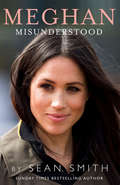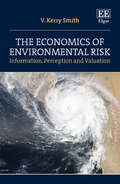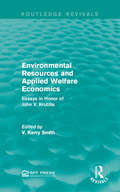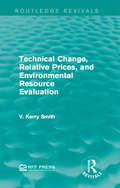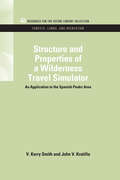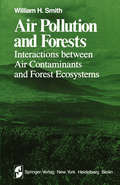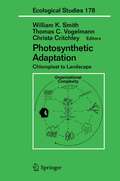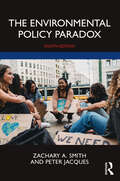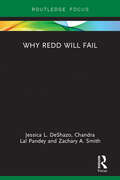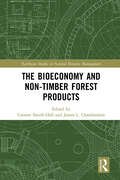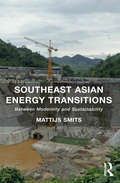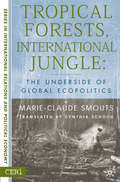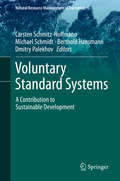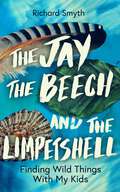- Table View
- List View
Meghan Misunderstood
by Sean SmithMeghan Misunderstood is a pioneering book that sets the record straight on the most talked about, unfairly vilified and misrepresented woman in the world.
The Economics of Environmental Risk: Information, Perception and Valuation
by V. K. SmithFeaturing real world examples of how risk information affects public choices, The Economics of Environmental Risk expertly demonstrates that policymakers need to consider how people learn about those risks. Offering insights into examples such as hazardous waste, radon, smoking, hurricanes and terrorist threats over the past four decades, this intuitive book illustrates environmental risks and the choices made to mitigate the potential effects.Providing a deep dive into how public policies and information affect private choices, this book highlights the successes and failings of these choices, recognising how decisions made can have an influence on the hazards that are faced. It also focuses on important lessons to be learnt by officials providing information on risk and designing policies for managing them. Further consideration is also given to how experts understand these risks and how the public interprets the information provided.Scholars and students of public policy, risk analysis and environmental and resource economics will value the useful examples found in this informative volume. Policymakers in risk and insurance, and risk management programs will also find this an instructive guide on the ever-changing environmental risks we face.
Environmental Resources and Applied Welfare Economics: Essays in Honor of John V. Krutilla (Routledge Revivals)
by V. Kerry SmithThis book, first published in 1988, provides an overview of the diverse work that was being done in applied and theoretical environmental and resource economics. Some essays reflect upon the background of the work of John Krutilla, one of the founders of Resources for the Future and a leading scholar of environmental economics, and the development of the field to date. Other essays examine and convey findings on particular resource problems and theoretical issues and resource policies and the practice of applied welfare economics. This title will be of interest to students of economics and environmental studies.
Environmental Resources and Applied Welfare Economics: Essays in Honor of John V. Krutilla (Routledge Revivals)
by V. Kerry SmithThis book, first published in 1988, provides an overview of the diverse work that was being done in applied and theoretical environmental and resource economics. Some essays reflect upon the background of the work of John Krutilla, one of the founders of Resources for the Future and a leading scholar of environmental economics, and the development of the field to date. Other essays examine and convey findings on particular resource problems and theoretical issues and resource policies and the practice of applied welfare economics. This title will be of interest to students of economics and environmental studies.
Technical Change, Relative Prices, and Environmental Resource Evaluation (Routledge Revivals)
by V. Kerry SmithOriginally published in 1974, Technical Change, Relative Prices, and Environmental Resource Evaluation explores the relationship between natural environmental resources and the differential implications of technological change and relative price appreciation. Smith claims that price is linked to technological progress and comments on the economic issues surrounding this. This title will be of interest to students of Environmental Studies and Economics.
Technical Change, Relative Prices, and Environmental Resource Evaluation (Routledge Revivals)
by V. Kerry SmithOriginally published in 1974, Technical Change, Relative Prices, and Environmental Resource Evaluation explores the relationship between natural environmental resources and the differential implications of technological change and relative price appreciation. Smith claims that price is linked to technological progress and comments on the economic issues surrounding this. This title will be of interest to students of Environmental Studies and Economics.
Structure and Properties of a Wilderness Travel Simulator: An Application to the Spanish Peaks Area (RFF Forests, Lands, and Recreation Set)
by V. Kerry Smith John V. KrutillaFirst Published in 2011. Routledge is an imprint of Taylor & Francis, an informa company.
Structure and Properties of a Wilderness Travel Simulator: An Application to the Spanish Peaks Area (RFF Forests, Lands, and Recreation Set)
by V. Kerry Smith John V. KrutillaFirst Published in 2011. Routledge is an imprint of Taylor & Francis, an informa company.
Birds of Prey
by Wilbur SmithThe year is 1667. Sir Francis Courtney and his son Hal are on patrol in their fighting caravel off the Agulhas Cape of South Africa. They are lying in wait for one of the treasure-laden galleons of the Dutch East India Company returning from the Orient. so begins a quest for adventure and the spoils of war that sweeps them from the settlement of Good Hope at the southern tip of Africa to the Great Horn of Ethiopia far to the north - at a time when international maritime law permitted acts of piracy, rape, and murder otherwise punishable by death. Wilbur Smith introduces a generation of the indomitable Courtneys and thrillingly re-creates their part in the struggle for supremacy and riches on the high seas. From the very first pages, Wilbur Smith spins a colorful and exciting tale, crackling with tension and drama, that builds and builds to a stunning climax. Packed with vivid descriptive passages of the open seas, breathless pacing, and an extraordinary cast of characters, Birds of Prey is a masterpiece from a storyteller at the height of his powers.
The Tiger’s Prey: A Novel Of Adventure (Courtney Family Novels Ser.)
by Wilbur SmithThe Malabar coast is full of dangers: greedy tradesmen, fearless pirates, and men full of vengeance. But for a Courtney, the greatest danger might just be his own family…
Air Pollution and Forests: Interactions Between Air Contaminants and Forest Ecosystems (Springer Series on Environmental Management)
by William H. SmithThis series is dedicated to serving the growing community of scholars and practitioners concerned with the principles and applications of environmental management. Each volume will be a thorough treatment of a specific topic of importance for proper management practices. A fundamental objective of these books is to help the reader discern and implement man's stewardship of our environment and the world's renewable resources. For we must strive to under stand the relationship between man and nature, act to bring harmony to it, and nurture an environment that is both stable and productive. These objectives have often eluded us because the pursuit of other individual and societal goals has diverted us from a course of living in balance with the environment. At times, therefore, the environmental manager may have to exert restrictive control, which is usually best applied to man, not nature. Attempts to alter or harness nature have often failed or backfired, as exemplified by the results of imprudent use of herbicides, fertilizers, water, and other agents. Each book in this series will shed light on the fundamental and applied aspects of environmental management. It is hoped that each will help solve a practical and serious environmental problem.
Photosynthetic Adaptation: Chloroplast to Landscape (Ecological Studies #178)
by William K. Smith Thomas C. Vogelmann Christa CritchleyThis is a thorough study of photosynthetic mechanisms from cells to leaves, crown, and canopy. The authors question whether photosynthetic adaptations take place primarily at the metabolic and biochemical level or through changes in structure and form, or both. The text goes on to analyze the relative importance of genes that control metabolic and light reactions, and the structure, arrangement, and orientation of photosynthesis.
The Environmental Policy Paradox
by Zachary A. Smith Peter JacquesNow in its eighth edition, The Environmental Policy Paradox continues the book's tradition of offering an accessible introduction to the social, economic, legal, and political matters pertaining to environmental policy while also developing the student’s own unique views. The text explains why some environmental ideas shape policy while others do not and illustrates that even when the best short- and long-term solutions to environmental problems are identified, the task of implementing these solutions is often left undone or is completed too late. New to the eighth edition: New topics including environmental social movements and the anti-environmental countermovements, environmental justice, corporate influence in regulatory affairs. Analyzes the growing policy divide between the two parties, and the efforts of both Republicans and Democratic presidents to undo the policies of their predecessor. Updated discussions of environmental justice issues. Includes a range of visual aids in figures and tables to demonstrate trends in the topics covered. A new co-author, Peter Jacques, recognized for his teaching and scholarship in global environmental politics and sustainability. A must-buy for courses in Environmental Policy, Environmental Studies, and Public Policy; and as a supplement for courses in American Government and Public Administration.
The Environmental Policy Paradox
by Zachary A. Smith Peter JacquesNow in its eighth edition, The Environmental Policy Paradox continues the book's tradition of offering an accessible introduction to the social, economic, legal, and political matters pertaining to environmental policy while also developing the student’s own unique views. The text explains why some environmental ideas shape policy while others do not and illustrates that even when the best short- and long-term solutions to environmental problems are identified, the task of implementing these solutions is often left undone or is completed too late. New to the eighth edition: New topics including environmental social movements and the anti-environmental countermovements, environmental justice, corporate influence in regulatory affairs. Analyzes the growing policy divide between the two parties, and the efforts of both Republicans and Democratic presidents to undo the policies of their predecessor. Updated discussions of environmental justice issues. Includes a range of visual aids in figures and tables to demonstrate trends in the topics covered. A new co-author, Peter Jacques, recognized for his teaching and scholarship in global environmental politics and sustainability. A must-buy for courses in Environmental Policy, Environmental Studies, and Public Policy; and as a supplement for courses in American Government and Public Administration.
Why REDD will Fail (Routledge Studies in Environmental Policy)
by Zachary A. Smith Chandra Lal Pandey Jessica L. DeShazoReducing Emissions from Deforestation and forest Degradation (REDD) attempts to address climate change from one angle – by paying developing countries to slow or stop deforestation and forest degradation. Trumpeted as a way to both mitigate climate change and assist countries with development, REDD was presented as a win-win solution. However, there have been few attempts to understand and analyse the overall framework. Why REDD Will Fail argues that the important goals will not be met under the existing REDD regime unless the actual drivers of deforestation and forest degradation are diminished. The book delves into the problematic details of the regime, ranging from; national capacity to monitor results, the funding mechanism, the definition of a forest, leakage, and the impetus behind the drivers of deforestation and forest degradation. As the international community rallies around REDD and developed countries and companies are willing to commit substantial amounts to implement the scheme, this books seeks to address whether REDD has the potential to achieve its purported goals. This is an important resource for academics and students interested in the policy and management aspects of mitigating climate change, environmental policy, international relations and development studies as well as policy makers involved in the REDD process.
Why REDD will Fail (Routledge Studies in Environmental Policy)
by Zachary A. Smith Chandra Lal Pandey Jessica L. DeShazoReducing Emissions from Deforestation and forest Degradation (REDD) attempts to address climate change from one angle – by paying developing countries to slow or stop deforestation and forest degradation. Trumpeted as a way to both mitigate climate change and assist countries with development, REDD was presented as a win-win solution. However, there have been few attempts to understand and analyse the overall framework. Why REDD Will Fail argues that the important goals will not be met under the existing REDD regime unless the actual drivers of deforestation and forest degradation are diminished. The book delves into the problematic details of the regime, ranging from; national capacity to monitor results, the funding mechanism, the definition of a forest, leakage, and the impetus behind the drivers of deforestation and forest degradation. As the international community rallies around REDD and developed countries and companies are willing to commit substantial amounts to implement the scheme, this books seeks to address whether REDD has the potential to achieve its purported goals. This is an important resource for academics and students interested in the policy and management aspects of mitigating climate change, environmental policy, international relations and development studies as well as policy makers involved in the REDD process.
The bioeconomy and non-timber forest products (Earthscan Studies in Natural Resource Management)
by Carsten Smith-Hall James ChamberlainThis book provides the first in-depth investigation of how non-timber forest products are an integral part of local, national, and global bioeconomies. While the plants and fungi that produce non-timber forest products are essential to the sustainability of forest ecosystems, peoples' food and livelihood security and sovereignty, and thus the bioeconomy, are often absent from bioeconomic strategies. Presenting a selection of empirical cases from around the world that engage with the bioeconomy and non-timber forest products, this volume reveals how essential these products are to creating a greener and more sustainable future, how to to better integrate them into efforts to transition to and expand the bioeconomy, and how such efforts can be supported and developed. Chapters analyse how and to what degree non-timber forest products promote sustainable resource use, generate employment, and contribute to food and livelihood security and poverty alleviation. The volume develops approaches and identifies interventions and policies to support the integration of non-timber forest products into bioeconomy strategies, including in national reporting schemes to provide recommendations for future research and practical implementation. This book will be of great interest to students and scholars of forest and natural resource management, bioeconomics, circular economy and ecological economics more widely. It will also be of interest to professionals working in sustainable development and the forestry sector.
The bioeconomy and non-timber forest products (Earthscan Studies in Natural Resource Management)
by Carsten Smith-Hall James L. ChamberlainThis book provides the first in-depth investigation of how non-timber forest products are an integral part of local, national, and global bioeconomies. While the plants and fungi that produce non-timber forest products are essential to the sustainability of forest ecosystems, peoples' food and livelihood security and sovereignty, and thus the bioeconomy, are often absent from bioeconomic strategies. Presenting a selection of empirical cases from around the world that engage with the bioeconomy and non-timber forest products, this volume reveals how essential these products are to creating a greener and more sustainable future, how to to better integrate them into efforts to transition to and expand the bioeconomy, and how such efforts can be supported and developed. Chapters analyse how and to what degree non-timber forest products promote sustainable resource use, generate employment, and contribute to food and livelihood security and poverty alleviation. The volume develops approaches and identifies interventions and policies to support the integration of non-timber forest products into bioeconomy strategies, including in national reporting schemes to provide recommendations for future research and practical implementation. This book will be of great interest to students and scholars of forest and natural resource management, bioeconomics, circular economy and ecological economics more widely. It will also be of interest to professionals working in sustainable development and the forestry sector.
Southeast Asian Energy Transitions: Between Modernity and Sustainability
by Mattijs SmitsAddressing the apparent tensions between modernity and sustainability in Southeast Asia, this book offers novel insights into the global challenge of moving towards a low carbon energy system. With an original and accessible take on social theory related to energy transitions, modernity and sustainability, Mattijs Smits argues for a reinvigorated geography of energy. He also challenges universalistic and linear assumptions about energy transitions and makes the case for ’energy trajectories’, stressing embeddedness, contingency and connections between scales. Contemporary and historical empirical examples from Southeast Asia, primarily Thailand and Laos, are drawn upon to show the importance of scale at regional, national, local and household levels. The transitions in the national power sectors here have been intimately related to discourses of modernity and state formation since the colonial era. More recently, plans for international cooperation and discourses of regional power trade have taken centre stage. Local energy trajectories are understood to be part of these transitions, but also as embedded in local social, political and spatial relations. Examining how energy practices go hand-in-hand with the dissemination of different technologies, this work shows the complexities of achieving sustainability in the context of rapidly changing energy modernities in Southeast Asia.
Southeast Asian Energy Transitions: Between Modernity and Sustainability
by Mattijs SmitsAddressing the apparent tensions between modernity and sustainability in Southeast Asia, this book offers novel insights into the global challenge of moving towards a low carbon energy system. With an original and accessible take on social theory related to energy transitions, modernity and sustainability, Mattijs Smits argues for a reinvigorated geography of energy. He also challenges universalistic and linear assumptions about energy transitions and makes the case for ’energy trajectories’, stressing embeddedness, contingency and connections between scales. Contemporary and historical empirical examples from Southeast Asia, primarily Thailand and Laos, are drawn upon to show the importance of scale at regional, national, local and household levels. The transitions in the national power sectors here have been intimately related to discourses of modernity and state formation since the colonial era. More recently, plans for international cooperation and discourses of regional power trade have taken centre stage. Local energy trajectories are understood to be part of these transitions, but also as embedded in local social, political and spatial relations. Examining how energy practices go hand-in-hand with the dissemination of different technologies, this work shows the complexities of achieving sustainability in the context of rapidly changing energy modernities in Southeast Asia.
Tropical Forests, International Jungle: The Underside of Global Ecopolitics (CERI Series in International Relations and Political Economy)
by M. SmoutsMarie-Claude Smouts looks at the issue of rain forest depletion and global environmental policies. Beginning with how the issue entered the world stage in the 1980s despite alarms over the issue in the 1950s, Tropical Forests, International Jungle explores the complexities of what are tropical forests, what role they play not only in environmentalism but in trade, health care, and almost every facet of natural and social life for those living there and beyond. Although for most in the developed world tropical forests have gained a status of part of our world heritage, these forests are not really part of the global commons or a global public good. Developing nations maintain control over the forests within their borders and often use the forests as they see fit. The international system for mediating the issue is a fractured group of non-governmental organizations and transnational networks, often with competing views of how to manage tropical forests. Despite this seemingly grim picture, Smouts is optimistic. A changing world view toward forest depletion is influencing countries both North and South. Although forests will be used commercially, it is a dynamic process that should maintain them far into the future.
Voluntary Standard Systems: A Contribution to Sustainable Development (Natural Resource Management in Transition #1)
by David M. SmythEmerging to the forefront of sustainable production and consumption are a promising and rapidly evolving concept known as Voluntary Standard Systems (VSS). They encompass the three pillars of sustainability – social, environmental and economic aspects and consequently they can be considered as a tool, which makes sustainable development visible. Currently, they are becoming a significant element in international trade and in the promotion of sustainable development strategies, especially in the context of globalised markets and supply chains.This volume provides a comprehensive overview of the current VSS concepts: from their nature and functioning, to the future outlook for their development. It places VSS in the broader context of global development issues and challenges, including development policy and international sustainability commitments, progress towards achieving ‘green economy’ and meeting climate protection targets. The volume contains also a representative selection of case studies which demonstrate their wide range of application in different sectors of the economy.
The Jay, The Beech and the Limpetshell: Finding Wild Things With My Kids
by Richard Smyth'Generous, moving and alive. A gift' - Tim Dee, author of Greenery'Intelligent, thought-provoking and always, always interesting' - Cal Flyn, author of Islands of Abandonment'Smyth writes with warmth and engaging perception about our relationship and understanding of the natural world on our doorsteps' - Jon Dunn, author of The Glitter in the Green'Fresh and tender and playful' - Patrick Galbraith, author of In Search of One Last SongWeren't they richer, rock pools, wasn't the seashore busier, when I was a kid?Richard Smyth had always been drawn to the natural world, but when he became a father he found a new joy and a new urgency in showing his kids the everyday wild things around them. As he and his children explore rockpools in Whitley Bay, or the woods and moors near his Yorkshire home, he imagines the world they might inhabit as they grow up. Through different objects discovered on their wanderings - a beech leaf, a jay feather, a limpetshell - Smyth examines his own past as well as that of the early natural historians, weaving together history, memoir, and environmentalism to form a new kind of nature writing: one that asks both what we have lost, and what we have yet to find.
Camp Six: The 1933 Everest Expedition
by Frank SmytheFrank Smythe's Camp Six is one of the greatest Everest accounts ever written. It is the story of the 1933 Everest Expedition, in which Smythe, climbing alone after his partner Eric Shipton had turned back ill, reached a point perhaps higher than any man had done before - and some twenty years before the eventual first ascent. Rope-less, oxygen free and in terrible snow conditions, his climb was one of the greatest endeavours in the history of Everest. Camp Six is a compelling read: a gripping adventure on the highest mountain in the world and a fascinating window into early mountaineering and Himalayan exploration - including an illuminating colonial view of early travels in Tibet. It is essential reading for all those interested in Everest and in the danger and drama of those early expeditions. Frank Smythe was one of the leading mountaineers of the twentieth century, an outstanding climber who, in his short life - he died aged forty-nine -was at the centre of high-altitude mountaineering development in its early years. Author of twenty-seven immensely popular books, he was an early example of the climber as celebrity.
Climbs and Ski Runs
by Frank Smythe"Why do you climb?" The mountaineer has no answer to this question. The best things in the world cannot adequately be expressed in speech or print; they are part of the soul.' In Climbs and Ski Runs, Frank Smythe takes the reader on Alpine ski trips and Dolomite adventures, up first ascents in North Wales and on to the mighty Brenva Face of Mont Blanc. He places pebbles for runners, 'shoots' crevasses and is struck by lightning. And yet, all the while, he perfectly captures the moments that make climbing and mountaineering so special - moments that will resonate with anybody who has spent time in the hills. Frank Smythe was among the leading mountaineers of the early twentieth century and one of the finest climbing writers ever to put pen to paper. In Climbs and Ski Runs he documents his early forays into the mountains, giving a remarkable insight into that period of climbing and mountaineering. Yet it is not this that makes the book special. It is Smythe's ability to observe and recreate his surroundings and to write so compellingly about the climber's response to them, and to the moments of difficulty and danger, that brings Climbs and Ski Runs to life.
